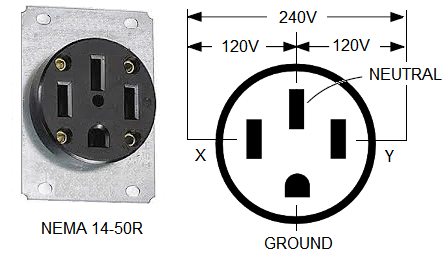Hello all.
I recently purchased a Tesla Model S 60 in Lithuania, imported from the US.
I have a whole bunch of charging cables and adapters but mostly are US specific and not very useful here in Lithuania.
I am able to charge using a standard Euro outlet at around 12a@220v, but this only gives me 10kph charging speed. Luckily I have a CHAdeMo adapter and a 3 charging stations near my home where I can charge at 150kph.
However, I am hoping to be able to get a bit more charging speed at home. I have a RED 3P+N+E outlet which should give me 3-phases at 32amps and 220v.
As I understand, USA Tesla's can only handle single phase charging, meaning I can only use 1 of these phases. Still, charging at around 30kph would be preferably to 10kph.
I also have a NEMA 14-50 plug that came with my charger. I have read that it has 2x Live/Hot wires, a neutral and a ground wire. Total 4 wires. I understand that 1 hot wire is supposed to be 110v and the other 208v. Does that mean these are 2 different phases or or they actually the same phase, but 1 with a stepped down voltage?
I looking to build an adapter for me RED 3P+N+E outlet which has a true 3-Phase supply. Given the Tesla can only charge using a single phase, I assume that 1 hot wire is kind of redundant? Or does it use both hot wires as they are actually a single phase?
In which case, when wiring the adapter do I just use a single phase from the RED 3P+N+E socket or 2? I assume I need to use 1.
If using only a single phase, then do I connect to just 1 pin on the NEMA 14-50 socket or connect to both? In which case both 'live/hot' terminals would actually come from the same phase.
Given the RED socket is rated at 32A, I am aware that I would need to lower the charging current in the car so to avoid tripping the trip switch or burning through the wires.
Thanks for the help in advance!
I recently purchased a Tesla Model S 60 in Lithuania, imported from the US.
I have a whole bunch of charging cables and adapters but mostly are US specific and not very useful here in Lithuania.
I am able to charge using a standard Euro outlet at around 12a@220v, but this only gives me 10kph charging speed. Luckily I have a CHAdeMo adapter and a 3 charging stations near my home where I can charge at 150kph.
However, I am hoping to be able to get a bit more charging speed at home. I have a RED 3P+N+E outlet which should give me 3-phases at 32amps and 220v.
As I understand, USA Tesla's can only handle single phase charging, meaning I can only use 1 of these phases. Still, charging at around 30kph would be preferably to 10kph.
I also have a NEMA 14-50 plug that came with my charger. I have read that it has 2x Live/Hot wires, a neutral and a ground wire. Total 4 wires. I understand that 1 hot wire is supposed to be 110v and the other 208v. Does that mean these are 2 different phases or or they actually the same phase, but 1 with a stepped down voltage?
I looking to build an adapter for me RED 3P+N+E outlet which has a true 3-Phase supply. Given the Tesla can only charge using a single phase, I assume that 1 hot wire is kind of redundant? Or does it use both hot wires as they are actually a single phase?
In which case, when wiring the adapter do I just use a single phase from the RED 3P+N+E socket or 2? I assume I need to use 1.
If using only a single phase, then do I connect to just 1 pin on the NEMA 14-50 socket or connect to both? In which case both 'live/hot' terminals would actually come from the same phase.
Given the RED socket is rated at 32A, I am aware that I would need to lower the charging current in the car so to avoid tripping the trip switch or burning through the wires.
Thanks for the help in advance!



